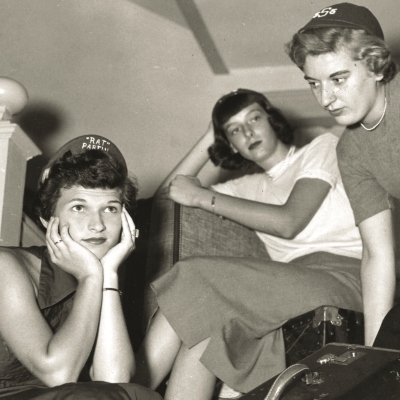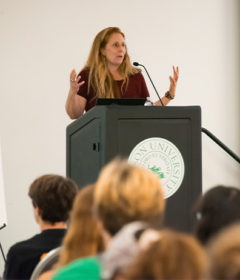Rat Week – A look back at Hatter Homecomings

Looking back at the female life of a lowly freshman rat, mid-1950’s
Whew! Your parents have just pulled away from your dorm, and you’ve started to meet your hallmates and roommates. As you try to squeeze your latest sweater set and saddle shoes into the tiny closets, you notice a letter stating there will be a hall meeting tonight to go over the rules and regulations of “Rat Week.” Rat what? Girls start whispering about little green beanies that must be worn for a week – something called a Rat Cap – and carrying books for the upperclassmen while having to obey their silly requests, or else. Or else what?
The meeting begins. And, according to Stetson University Archives, freshmen are handed a sheet that reads: Girls’ Rat Rules to be followed during the week of October 3 through October 8, 1955.
No Rat is to be in the Soda Shop between the hours of 9:30 a.m. and 10:30 a.m. (Rule in effect until the end of Ratting.)
Handbooks will be carried at all times. Songs and cheers will be recited at the request of upper-class girls.
All reasonable requests by upper-class girls (sophomores, juniors and seniors), who will be addressed as “Miss,” will be carried out.
A wooden clothespin will be worn in each girl’s hair from 6 a.m. until 6 p.m. and must be signed by the Freshman Class Officers of the preceding year (1954-1955) Eugene Caruthers (President), Joe Folds ’59 (Vice President), Pat Chapman ’58 (Secretary), Wilabeth Peck (Treasurer).
A paper-cutout rat will be hung around the neck during Rat Week, and Rat Caps must worn at all times.
Also outlined in the Girls Rat Rules of 1955, the required Rat Apparel for each day of the week was: Monday– Sunday dress-hat, heels and gloves; Tuesday – P.E. T-shirt, skirt, tennis shoes, no socks and no makeup. Wednesday – Kiddie Day, dress accordingly with hair in 10 pigtails and no makeup; Thursday – School dress, no makeup and no jewelry; Friday – Skirt upside down and inside out, different color socks, no makeup with earrings and carry books in pillowcase.
“Rat Court wasn’t so bad,” wrote Marilyn Jean (Stuart) Sullins ’55 to her mother following Rat Week Oct. 6, 1951. “Everybody was such good sports about Rat Week we didn’t have to do anything on Friday except obey upperclassmen. Well, I was happy it was over, but when I went to lunch at the Commons I found out it wasn’t. Barbara Harris (another freshman) and I walked into the big lounge in front of the Commons (where we eat) and there were three football players sitting there. As we walked by them they said, ‘Hey rats, come here.’ Since we had to obey all upperclassmen, we did. They said, ‘O.K., you two rats, stand up on this table (which was in front of them) and sing the school song ‘Here Comes Our Team in Green and White.’ We got halfway through the song and we started laughing and couldn’t sing so they made us sing it all over again… If Stetson wins the Tampa game Oct. 20, we can take our rat hats off for good. If they don’t, we have to wear them until Thanksgiving.”
Rat week was discontinued in 1964 for various reasons according to a Stetson Reporter article written by Angel Castillo ’68 in 1966. “Professors and administrators objected to the foolishness of this archaic ritual,” wrote Castillo. “Upperclassmen were too interested in dating the new girls to be mean to them, all Greeks in general were too concerned about rushes to enforce Rat rules, and freshmen were too worried about getting a good academic start…than doing push-ups at 3 a.m.”
Rat Week was terminated in 1964 due to faculty and administration considering it a form of hazing. “What started out in 1913 of calling the freshmen Rats, (for one whole semester, then evolved into one week of doing silly chores in silly dress) ended without a whimper,” said Sullins. “All we have left are the little Rat Caps to remind us of the fun of that freshman experience.”
To Haze Not
Rat Week at Stetson in the 1950s to some may be a far cry from some of the humiliating and dangerous activities for which members of college fraternities, sororities, marching bands, athletic teams and other student organizations have been banned or faced civil liabilities in recent years. “Being involved in student organizations and athletic teams does greatly enhance the development of students and their college experience,” said Christopher Kandus, Vice President of Student Affairs. “Especially when an organization’s membership criteria is based on mutual respect, with social and moral responsibility. It truly can contribute to the student’s holistic educational experience.”
In keeping with this principle, and in view of the possibility of abuses by student organizations at Stetson and university campuses throughout the country, action that produces physical discomfort, embarrassment, harassment or ridicule, is subject to a review. “Stetson University has a zero tolerance policy when it comes to any hazing action,” said Assistant Dean of Students Rosalie Carpenter ’98, “and appropriate action is taken by the Office of Judicial Affairs should any resemblance of hazing occur. It is unfortunate that behavior typically well-intended can evolve into potential life-threatening situations for today’s students. The great news is that offices like the Vice President for Student Affairs, and Student Engagement and Development work hard to educate and partner with student leadership to ensure that fantastic school spirit, student involvement and campus vibrancy are alive and well today, and practiced in a safe manner. As an alumni member, I can attest that many alumni do treasure these memories just as much as past generations.”
If you have a Stetson experience you’d like to share from decades past, please contact SU Magazine at SUM@ stetson.edu or call (386)822-7284.Together with the Dean of the duPont-Ball Library and Digital Learning Resource Specialist Susan Ryan and Archives Specialist Gail Grieb, who knows what archived images and memorabilia could be discovered?!
By library archives specialist, Gail Grieb ‘67
Published in the Spring/Summer 2012 edition
Of SU Magazine



